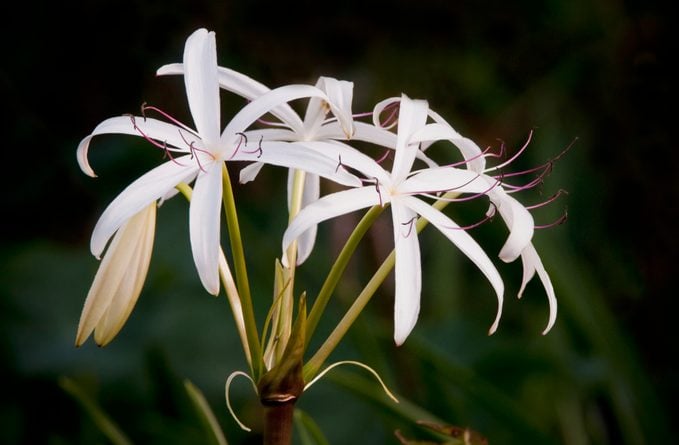Seeds, Fertilizer & More
The daisy’s bright white petals and sunny centre are a popular symbol of innocence, purity, and new beginnings. Daisy plants bloom in spring and summer and love a sunny, well-draining spot.
Hemerocallis, or daylilies, are a popular perennial flowering plant with many beautiful cultivars in vibrant colors. These flowers are easy to grow and thrive in full sun.
Learn what makes a crinum lily a staple in Southern gardens, and find out which pollinators and backyard visitors are drawn to its flowers.
How to Care for a Crinum Lily

Botanical Name: Crinum
Growing Zone: 6 to 10 (depending on variety)
Light Needs: Full sun to part shade
Soil: Well-drained
Attracts: Butterflies, hummingbirds, moths
Crinum lilies are a staple of Southern summer gardens, where they bloom in mid- to late summer. In most areas, they can be planted starting in April through October. Crinum lilies bloom best in full sun, although they will also tolerate part shade. If you don’t immediately see flowers from your brand-new crinum lily, don’t fret. They can take a year or two to produce the blossoms many gardeners cherish.
The flowers can have a variety of appearances, too, with some looking more traditionally “lily”-esque, while others have a “spidery” appearance.
Do note that all parts of the plant, including the bulb and foliage, are poisonous.
Find more lilies to add to your garden with our guide to the 10 beautiful lily flowers to love.
Benefits of Growing Crinum Lily
Two favorite backyard visitors, butterflies and hummingbirds, enjoy crinum lily. Other pollinators are also drawn to the flowers.
The plants are generally deer-resistant. But gardeners should watch for other pests like spider mites, grasshoppers, slugs or mealybugs. They may be affected by powdery mildew in warm, humid conditions.
Learn how to grow tropical ginger lilies in your garden.
Ask the Experts

“My mystery plant has produced a flower for the first time in 15 years. What is it?” asks Birds & Blooms reader Elaine Comarella of Marion, New York.
Horticultural expert Melinda Myers: Your plant is a type of crinum lily. As you discovered, it takes several years to reach maturity and begin blooming. Grow crinum lilies in a sunny location with moist, well-draining soil. And be patient. Some crinum lilies are hardy and survive winters north of New York City.
Gardeners in cold regions should plant hardier types suited to their climate in a sheltered location. Mulch for winter to increase the chance of overwintering success. Reduce watering once the flowers fade to encourage the plant to enter dormancy.
Some crinum lilies are hardy only to Zones 7 or warmer and need to be moved indoors for winter. Dig the bulbs out of the ground or move the container indoors once the leaves die back. Store in a 50-degree location.
Next, discover the differences between daylilies and true lilies.
Popular Videos
Source: birdsandblooms.com

Leave a Reply